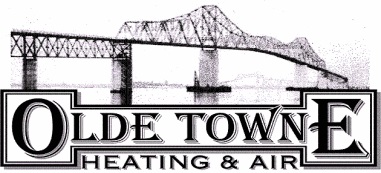
Ceiling fans are one of the most underappreciated ways to make your home more comfortable and reduce energy costs. By improving air circulation and supporting your HVAC system, ceiling fans and energy efficiency are truly a perfect combination. They offer a practical, eco-friendly way to keep cool while reducing strain on your AC—potentially sparing you from unnecessary air conditioning repair.
In this blog, the experts at Olde Towne Heating & Air explain how ceiling fans can make your home feel more comfortable while increasing your HVAC efficiency. We'll also offer some HVAC efficiency tips that make the most of ceiling fans.
Comfort vs. Temperature: The Effect of the Wind-Chill Effect Indoors
Ceiling fans don’t actually cool the air—they make your home more comfortable by increasing air movement across your skin. This is called the wind-chill effect, and it can make a room feel up to 4 degrees cooler without adjusting the thermostat. That means you feel less hot and enjoy the benefits of indoor air circulation from your ceiling fan while minimizing air conditioner use—helping reduce your electric bill in summer.
The Best of Both: Advantages of Pairing Fans and Air Conditioning Together
There are several benefits to using ceiling fans and air conditioning in tandem, especially on hotter days. By pairing both, you maximize HVAC efficiency and maintain a comfortable indoor temperature with less work from your cooling system.
Benefits of using ceiling fans and AC together:
- Ceiling fans help lower HVAC load by spreading cool air more evenly around the room. Decreasing HVAC stress is important, because it can prevent a breakdown that may lead to premature AC or furnace installation.
- Using overhead fans improves your indoor comfort by eliminating hot spots and improving air movement.
- Pairing ceiling fans and AC can reduce overall energy use. If you have a home automation system, you can even modify your smart thermostat settings to set the temperature higher while your ceiling fan is running.
Clockwise vs. Counterclockwise Ceiling Fan Rotation: Which Direction Should a Fan Spin?
To make full use of your ceiling fans year-round, it’s important to ensure blades are rotating in the proper direction for the season. The direction affects how air moves, which can either cool you down or redistribute heat so you feel warmer.
When to rotate ceiling fans counterclockwise
On hot days, ceiling fans should rotate counterclockwise at a faster setting. This creates a breeze that moves air toward the floor, increasing the wind-chill effect and making you feel cooler.
When to spin ceiling fans clockwise
In the winter, set your fan to rotate clockwise on a gentle setting. This gently pulls cool air upward and draws warm air downward from the ceiling, so you feel warmer without touching your thermostat.
Things to Look for in a Ceiling Fan
Choosing the right ceiling fan depends on a few key factors, including blade design, airflow rating and room dimensions. First, look for fans that have a good balance of ECFM airflow and blade pitch to deliver efficient air movement in your home:
- ECFM refers to how much air a fan pushes—the cubic feet per minute, or CFM—per watt of electricity consumed. Fans with higher ECFM are more energy efficient.
- Blade pitch is the tilt of the blades. A steeper blade pitch moves more air than a shallower pitch but can also put extra load on the motor.
Also, consider room size when sizing a ceiling fan—a fan that’s too small won’t move enough air, while one that’s too large may be disruptive in a smaller room.
Increase Your HVAC Efficiency With the Team from Olde Towne Heating & Air
At Olde Towne Heating & Air, our HVAC experts can help you enjoy year-round comfort while minimizing wear on your heating and cooling systems. From practical fan advice and air conditioning installation to smart thermostats and furnace repair, we offer comprehensive services that work with your budget. Set up your appointment by calling 843-806-2049 today.
